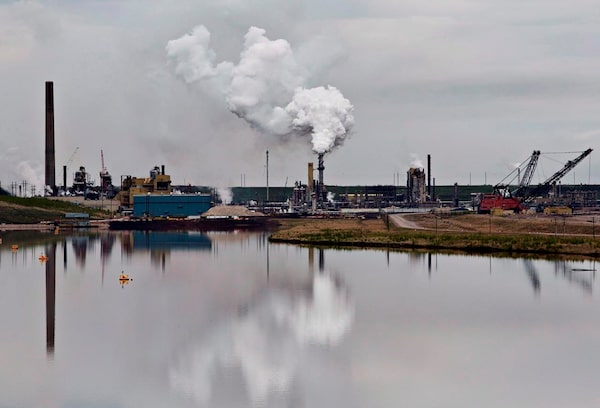
An oil sands extraction facility is reflected in a tailings pond near the city of Fort McMurray, Alta., on June 1, 2014.The Canadian Press
With the much-anticipated green agenda outlined in the Speech from the Throne, Justin Trudeau’s Liberals have recommitted to a path they promised in the prepandemic days – and have struggled to make much progress on since.
With the exception of a promise to create a new fund to attract investment in making zero-emissions products, every climate-related policy commitment in Wednesday’s address – from retrofitting buildings and expanding electric-vehicle infrastructure to banning single-use plastics and planting two billion trees – was also included in some form in last year’s Liberal re-election platform.
For all the recent work of environmental policy experts to come up with ways to seize this moment of crisis to expedite the shift to a cleaner economy, the government’s imperative is mostly to get on with its old ones.
It will attempt to do so by underscoring economic benefits of climate policy more than it has previously, as part of a broader pledge to create a million new jobs. And with that lens being applied, it’s possible to get some sense of which past commitments might now be newly prioritized and made more ambitious, which are closest to being ready for rollout, and which still need the most work.
The full federal Throne Speech: ‘This is an ambitious plan for an unprecedented reality’
A few of the takeaways about how the Liberals might finally get down to the monumental task of implementing their climate agenda in the months ahead:
RETROFITS ARE THE STIMULUS PROGRAM TO WATCH
The first climate-related investment promised in the speech is “retrofitting homes and buildings” to improve energy efficiency.
It’s easy to understand why that form of spending has had momentum in environmental policy circles through the pandemic. As the government seeks to prove climate investments can help rebuild the economy, retrofits stand out as a chance to quickly create a lot of jobs, while helping consumers with monthly bills and tangibly reducing emissions.
The government likely wants to have the program ready to implement as soon as the worst of the pandemic is sufficiently in the rearview mirror. And the implication that spending will be on commercial buildings as well as homes – only the latter were listed in the Liberal platform – suggests the scope has been widened.
ELECTRIC VEHICLES ARE GETTING A LOT OF THE CLEAN-TECH FOCUS
Hot off the first commitment by an auto manufacturer (Ford Motor Co. of Canada Ltd.) to build electric vehicles here, the speech holds them up as a preferred example of “adapting to a carbon-neutral future,” because combining Canada’s reserves of battery-component minerals with its auto-manufacturing expertise offers a “competitive edge.”
The Liberals don’t seem to have yet worked through all the policy steps that might be needed to help build that supply chain. But the speech recommits to a couple of measures to increase domestic demand – making electric vehicles “more affordable,” which is code for purchase incentives atop existing ones, and “investing in more charging stations across the country.”
Expect to hear more about the latter in particular soon, because it’s another way to create jobs in a relatively short time.
CLIMATE ADAPTATION IS GOING TO GET MORE FOCUS
Although the Liberals previously said they will invest in preparing for extreme weather and other consequences of climate change, they haven’t given it much emphasis compared with avoiding those effects by cutting emissions. So it’s noteworthy that “reducing the impact of climate-related disasters, like floods and wildfires” is among the first green investments promised in the speech.
Here again, the desire for relatively short-term economic stimulus is probably part of the reason. Some of the adaptation measures could fit into the building retrofits; others are the sorts of community infrastructure spending that governments typically turn to coming out of recessions.
RESHAPING THE RESOURCE SECTOR IS GETTING A SOFTER TOUCH
In their platform, the Liberals promised a “just transition” for fossil-fuel workers. The implication was that those who rely on disappearing oil-and-gas jobs would be helped through training and other supports to find new work.
Wednesday’s address drops that terminology, instead promising to work with the energy industry and other traditional sectors to help them transform “to meet a net-zero future.” It’s a subtle distinction, but one seemingly meant to suggest partnership rather than abandonment of existing industries.
EMISSIONS REDUCTION TARGETS ARE READY FOR ROLLOUT
The one time the word “immediately” appears in the speech’s climate section is alongside the promise to “bring forward a plan to exceed Canada’s 2030 climate goal,” which under the Paris Agreement is a 30-per-cent reduction of greenhouse gas emissions from 2005 levels.
That suggests the announcement of that framework will be among the government’s first orders of business this fall, which squares with recent word out of Ottawa that it’s been a focus of Environment Minister Jonathan Wilkinson in recent months.
Cause for skepticism remains about the path to meeting the existing targets, let alone exceeding them, based on progress so far. But the plan could provide some of the accountability for which environmental advocates have long been calling – and some sense of how all the other promises fit in.
Our Morning Update and Evening Update newsletters are written by Globe editors, giving you a concise summary of the day’s most important headlines. Sign up today.
 Adam Radwanski
Adam Radwanski